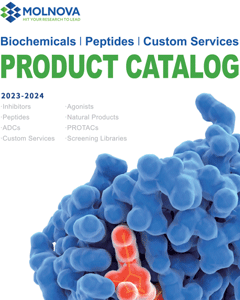
Simvastatin
CAS No. 79902-63-9
Simvastatin( MK-733 )
Catalog No. M15991 CAS No. 79902-63-9
A potent, competitive inhibitor of HMG-CoA reductase (HMGCR) with Kd of 0.1-0.2 nM.
Purity : >98% (HPLC)
 COA
COA
 Datasheet
Datasheet
 HNMR
HNMR
 HPLC
HPLC
 MSDS
MSDS
 Handing Instructions
Handing Instructions
| Size | Price / USD | Stock | Quantity |
| 10MG | 32 | In Stock |


|
| 25MG | 48 | In Stock |


|
| 50MG | 57 | In Stock |


|
| 100MG | 97 | In Stock |


|
| 500MG | 251 | In Stock |


|
| 1G | Get Quote | In Stock |


|
Biological Information
-
Product NameSimvastatin
-
NoteResearch use only, not for human use.
-
Brief DescriptionA potent, competitive inhibitor of HMG-CoA reductase (HMGCR) with Kd of 0.1-0.2 nM.
-
DescriptionA potent, competitive inhibitor of HMG-CoA reductase (HMGCR) with Kd of 0.1-0.2 nM; inhibits cholesterol synthesis in mouse L-M cell (fibroblast), rat H4II E cell (liver), and human Hep G2 cell (liver) with IC50 of 19.3 nM, 13.3 nM and 15.6 nM, respectively; also shows anti-inflammatory activity in inflammatory arthritis.Dyslipidemia Approved(In Vitro):Simvastatin is an inactive drug precursor that has no drug activity itself and must be metabolized into its hydroxy acid form in the liver to function. In vitro experiments, it can be activated by sodium hydroxide (NaOH).Simvastatin suppresses cholesterol synthesis in mouse L-M cell, rat H4II E cell, and human Hep G2 cell with IC50s of 19.3 nM, 13.3 nM and 15.6 nM, respectively.Simvastatin causes a dose-dependent increase in serine 473 phosphorylation of Akt within 30 minutes, with maximal phosphorylation occurring at 1.0 μM.Simvastatin (1.0 μM) enhances phosphorylation of the endogenous Akt substrate endothelial nitric oxide synthase (eNOS), inhibits serum-free media undergo apoptosis and accelerates vascular structure formation.Simvastatin shows anti-in?ammatory effects, reduces anti-CD3/anti-CD28 antibody-stimulated proliferation of PB-derived mononuclear cells and synovial ?uid cells from rheumatoid arthritis blood, as well as IFN-γ release at 10 μM.Simvastatin (10 μM) also blocks cell-mediated macrophage TNF-γ release induced via cognate interactions by appr 30%.Simvastatin (5 μM) significantly reduces the expression of ABCA1 in astrocytes and neuroblastoma cells, the expression of apolipoprotein E in astrocytes, and increases cyclin-dependent kinase 5 and glycogen synthase kinase 3β expression in SK-N-SH cells.Simvastatin has the ability to inhibit exosome release.Simvastatin (32 and 64 μM; 24, 48, and 72 h) inhibits tumor cell growth, arrests in the G0/G1 phase.Simvastatin (32 and 64 μM; 48 h) induces apoptosis in HepG2 and Huh7 cells. (In Vivo):Simvastatin suppresses the conversion of radiolabeled acetate to cholesterol with an IC50 of 0.2 mg/kg via p.o. administration. Simvastatin (4 mg/day, p.o. for 13 weeks) returns the cholesterol-induced increases in total cholesterol, LDL-cholesterol and HDL-cholesterol to normal level in rabbits fed an atherogenci cholesterol-rich diet.Simvastatin (6 mg/kg) increases LDL receptor-dependent binding and the number of hepatic LDL receptors in rabbits fed a diet containing 0.25% cholesterol.Simvastatin (20 mg/kg/day) causes a 1.3-fold less macrophage content in lesions, and 2-fold less vascular cell adhesion molecule-1, interleukin-1beta, and tissue factor expression, companied by a 2.1-fold increases in lesional smooth muscle cell and collagen content in cynomolgus monkeys fed an atherogenic diet.Simvastatin (oral gavage; 15 and 30 mg/kg; once daily; 14 d) treatment attenuats oxidative damage, TNF-a and IL-6 levels, and restores itochondrial enzyme complex activities.
-
In Vitro——
-
In Vivo——
-
SynonymsMK-733
-
PathwayMetabolic Enzyme/Protease
-
TargetHMGCR
-
RecptorHMG-CoAreductase
-
Research AreaCardiovascular Disease
-
IndicationDyslipidemia
Chemical Information
-
CAS Number79902-63-9
-
Formula Weight418.5662
-
Molecular FormulaC25H38O5
-
Purity>98% (HPLC)
-
Solubility10 mM in DMSO
-
SMILESC[C@H]1C=CC2=C[C@H](C)C[C@H](OC(C(C)(C)CC)=O)C2[C@H]1CC[C@@H]3C[C@@H](O)CC(O3)=O
-
Chemical NameButanoic acid, 2,2-dimethyl-, (1S,3R,7S,8S,8aR)-1,2,3,7,8,8a-hexahydro-3,7-dimethyl-8-[2-[(2R,4R)-tetrahydro-4-hydroxy-6-oxo-2H-pyran-2-yl]ethyl]-1-naphthalenyl ester
Shipping & Storage Information
-
Storage(-20℃)
-
ShippingWith Ice Pack
-
Stability≥ 2 years
Reference
1. Kureishi Y, et al. Nat Med. 2000 Sep;6(9):1004-10.
2. Slater EE, et al. Drugs. 1988;36 Suppl 3:72-82.
3. Leung BP, et al. J Immunol. 2003 Feb 1;170(3):1524-30.
molnova catalog



related products
-
Apomine
Apomine, an inhibitor of HMG-CoA-reductase, promotes apoptosis of myeloma cells in vitro and has been implicated in the regulation of myeloma in vivo. Apomine accelerates the degradation of 3-hydroxy-3-methylglutaryl-CoA reductase and stimulates low-density lipoprotein receptor activity.
-
Monacolin J
Monacolin J is a cholesterol biosynthesis inhibitor.
-
Pravastatin sodium
Pravastatin sodium is an?HMG-CoA reductase?inhibitor against sterol synthesis with IC50 of 5.6 μM.



 Cart
Cart
 sales@molnova.com
sales@molnova.com


